It’s all a matter of opinion. kind of like asking who was the best surfer in the history of the world. Or better yet “How do you measure rocker” Anybody want to answer that trick question?
Wait a second. I’m confused again. I thought we already determined the Aussies pretty much invented everything. Yah know, surfing, pintails, twins, ‘trusters’, toaster ovens, human flight, beer, muff diving, etc. Mike
pointy,
you're just mad you didn't make the list !
lol..............but you are a funny guy !!!!!!
herb
actually multi-finned boards go back to the 30's.
as bill t said, he did invent twins back in 70.
they even had rakey fins not keels.
that's where i got the idea for my rakes back in the mid 70s..........and where brewer and reno etc. got there inspiration from.
bill should be given alot of credit for the modern surfboard movement.
bill even invented the removable side-fins for 2+1 designs,long before anyone else had thought of it.
herb
never liked shaping other shaper's designs............especially over and over again.............kinda boring.
herb
[quote="$1"]
Come on the Dyno Nuuhiwa thing had already come and gone by the mid seventies in the OC area. I never heard of you Herb, before sways,
--------------------------------------------------------------------------------------------------------------------------------------------------
i shaped for dyno in 75' w/ rick mchale in longbeach....where i lived at the time.....keep.......ah.........cleanin' those croaker......lol.
herb
bill,
we all owe alot to you and your removable fins back then.
herb
Aloha Herb,
Thanks for the ''attaboy'' I did the prototype work on that fin system in Oct. 1970, and had the injection molded fins on the market by Feb.1971. G&S, Weber, Bing, Hobie, Surf Systems, and Surfboards Hawaii, as well as others used the system. I called it PressLock Fins. No tools needed, the fins had a .003/.005 inch friction/press fit. Yikes! That was 41 years ago! I still have some of those fins, and the plugs to form the box. So much of surfing history, and the men who made that history, are being lost each year. the younger surfing demographic (those under 50 yrs) in general, have no clue about who was doing cutting edge things. I was also making leash cups out of PVC end caps, with 1/4th inch nylon rod to tie to. Nothing to rust. Did that almost two yrs before there was a commercial one available to the public.
Didn’t know you shaped for Dyno back then that was a pretty cool shop, what about the “spacesticks”, and it seems they were doing the twinnies pretty hard around '72.
[quote="$1"]
Come on! the idea that Mark Richards invented the Twin is preposterous. He certainly was the main proponent of the design, but it already had a huge following in San Diego and Orange County Calif long before Mark Richards ever got his mug in a magazine.
[/quote]
I have read elsewhere that Geoff Mccoy was shaping twins for Mark Richards when he M.R. about 12 years old . I remember he was called the twin fin king a longtime before he was famous for single fins
Well I didn't read it in a magazine but there were Twin fins being shaped and ridden all over San Diego reefs and beach breaks in '69-70. But if a magazine says an Ozzie invented the Twinnie, I acquiese.
Rooster, sorry Dude
The question wasn’t asked to make someone feel bad , like their country wasn’t the most important .
Speaking of beer we did’nt invent it but we showed you how to drink it right.
I think the Kiwi’s are claiming human flight these days. ( They’re the smaller islands to our southeast. )
Cheers
Mooneemick
| 1978 Mark Richards Twin fin II 5 ft 10" | #40 |

**MANUFACTURE** **MANUFACTURER:** Maddog Surfboards, Industrial Estate, Byron Bay **SHAPER: ** Bob Margetts **DESIGN: **Mark Richards' Twin fin 2 **DESIGNER: **Mark Richards
SPECIFICATIONS
CONSTRUCTION: Foam blank, 1/8" redwood stringer, spray, r/h plug
DIMENSIONS
**Length :** | 5 | ft | 11 | inches | **L2 :** 5 ft | 10'' |
**Width :** | 19 3/4 | inches | **Wide Point :** | /+ x | inches | |
**Nose :** | 14 1/4 | inches | **Tail :** | 14 1/2 | inches | |
**Thickness :** | 2 1/2 | inches | **Pod :** | 5 3/4" | inches | |
**Nose Lift :** | inches | **Tail Lift :** | inches | |||
**Weight :** | kilos | **Volume :** | litres | |||
**Swallow:** | 1 1/2 | inches | deep | **Flyer:** | 7 | inches |
FEATURES
Nose: Pin
Tail: swallow tail, flyer
Deck: flat
Bottom: slight Vee in nose, deeper at fins, channel from fin base to rail
Rails: Tucked
Rocker:
| **FINS** 6" x 5" base x 7'' span @ 10 1/2'' Brewer, inside flat/outside foiled, toed and tipped/cambered Gold/white/red (3) laminate, |  |
| **DECOR** **DECALS** **Deck** 1.'Mark Richards' script and ribbon graphic, light blue/silver 2.'Shaped by Bob Margetts' black, tail **Bottom** 'Mark Richards' script and ribbon graphic, dark blue/white **MARKINGS** **Deck: **RM , pencil **Bottom:** **COLOUR** **Deck** Gold wing, nose to flyer + red winged foil, with black pinlines **Bottom: **clear |  Alternative later decal
below
Alternative later decal
below |
NOTES
BOARD HISTORY
Donated by John McInnes May 1996.
Repairs to swallow/flyer tips and leg rope damage.
SHAPER HISTORY
Knox: Mark Richards
DESIGN HISTORY
See below.
COMMENTS
Legrope damage indicates possible pre rail saver use, tip damage to the tail is emdemic to this design.
REFERENCES
Other Boards
#165
Book
Knox: Mark Richards pages 61 to…
Film
**Free Ride**1977 Bill Delany , Water footage by Dan Merkel.
Surfers : Shaun Tomson, **Mark Richards **and Rabbit Batholomew
*The definite film of this period, note that most of Mark Richards’ surfing is not on a Twin fin II .
**CONDITION: **8


**DESIGN HISTORY** **circa 1943** The earliest documented twin fin surfboard is probably a model built by Tom Blake, possibly in Hawaii, circa 1943. See cropped image, below. The uncredited photograph is currently the only known evidence.
 | **circa 1943,** Tom Blake Twin fins, Timber 4 x 12 b @ 2 inches (Approximation) Hollow timber board. Note fin camber. The feet are Tom Blake's. Uncredited photograph, **Australian Surfers Journal** Vol 3 No 1 Summer 2000 page 10. |
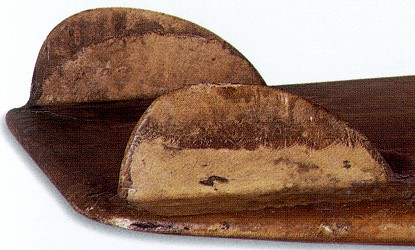 | **1948** **Simmons' Twin Fin** Wood and fibreglass 6 x 12 b @ 2 inches (approximation) Bob Simmons' Laminate Board, USA. Dick Metz Collection, Dana Point, California. **Blackburn**, page 73 |
| **1950's** During the 1950's prone boards appeared in a plethora of designs and constuction methods. See the **Paipo catalogue** for examples dating from the 1930's. A large proportion were finless, those that did attach a fin used a longbased keel type fin. Bellyboarders at some stage incorpated twin fins on their wide tailed boards, similar to the plywood example, right. With the introduction of foam blanks these design were reproduced in the new medium. See Barry Bennett example, below. | 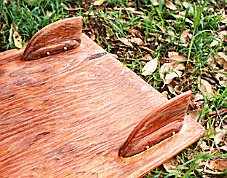 |
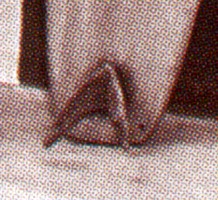 | **1955 ** **Butterfly Fin ** Laminated Timber 8 x 7 b @ 4 inches (Approximation) Velsy-Jacobs Surfboards USA Photograph : Bob Meistrell **Longboard Magazine** Vol 12 No 1 March -April 2004 page 33. |
The single fin template used by Velsey would not become common use until 1974. Apparently the production difficulties were not offset by improved performance. In 1978 the design was revived as a molded model for use in a standard fin box. The design was also (slightly) reflected in the Horan/Lexan Star Fin, 1980.
Fin experimentation on surfboards1950 to 1966 was extensive.
A variety of designs, some extreme, proliferated, however singularity and a standard 0’’ to 6’'placement remained a design constant.
1960
With the introduction of foam blanks, bellyboard riders had their plywood designs were reproduced in the new medium.
Generally the fins retained the long base keel profile and, consistant with surfboard fins of the era, foiling was minimal.
Placement was close to the tail with the fins vertical to the bottom and parrallel to the stringer.
1962 - 1964
In the US George Greenough built his first Velo Spoon in balsawood in 1962.
He reported that the board was originally …
"a twin fin, but as time went on, I moved the fins closer together, and it
kept working better and better. Eventually, it turned into a single fin!"
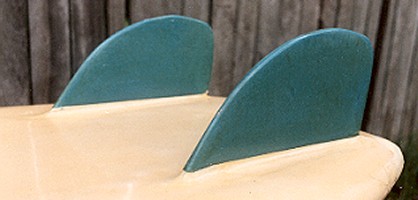 | **1964** **Twin Keel Fins**, Pigmented chop strand mat 4 1/2 x 9 1/2 b @ 1 inches **# 50 ** Barry Bennett Surfboards Belly board , |
**circa 1967** Bear Mirandon of **Surfboards La Jolla** used Simmons' Twin fin design and matched them with a slpit tail design. There was a precedent of this design in some early prone boards, see **Blackburn.**

**Surfboard La Jolla Twin-Pin, 1967** **Length 8'9" - Nose 17" Width 22" Tail 17"** **Shaped by La Jolla reef maven Bear Mirandon, the double-pin** **tailed twin-fin was an update of a Bob Simmons concept.** **This board led directly to the Fish kneeboard design** **of Steve Lis, which is still very much in use today.** Photograph by Bjorn de Boer Image and caption **Longboard Magazine, **Volume 2 Number 2, August - September 1994 page 69
In the USA, the situation was similar with a noted following lead by kneeboarders Steve Lis and Rex Huffman. Lis was credited with the development of **The Fish**, a design with long base twin fins and a split 'Fish' tail, circa 1969.. From the La Jolla area, Steve Lis was aware of an earlier design by Bear Mirandon precedent. The fish tail was later supplanted by the Swallow tail.
| Twin Fin I, see **#71** and **#106**, a circa 1970 design by Mike Eaton / Rolf Arness / Corky Carroll / David Nuuihwa -all USA.
Imported to Australia by Tom Hoye (USA) at **Bennett Surfboards**, the design had a strong following in Sydney, particularly at Narrabeen) by McCoy Surfboards.
Image right:
**Tom Hoye and Twin Fin, Bennett Surfboards, 1970**
Photograph **Tracks** Magazine.
**Nat-History**, page 106.
Although the design quickly disappeared from mainstream production in Australia, a number of surfers found the design complimented their style or local conditions. |  |
The use of twin fins on prone boards, common in the 1960’s, continued into the 1970’s, for example the mass produced Bellybogger, 1975.
The design was adopted by standup surfers, a longer version with with a more standard fin template, was designated The Rocket Fish, circa 1974, the name at least credited to Clyde Beatty.
There is much dispute amoungst US commentators as to the originators of the design.
This was to influence Reno Abellira, (Hawaii) who rode a 5 ft 3" x 20" model in the 1976 Coke contest, Sydney.
Familiar with the Twin Fin I and inspired by Reo, Mark Richards built his own version and subsequently refined it at a month long shaping seminar with Dick Brewer in Hawaii 1976-1977.
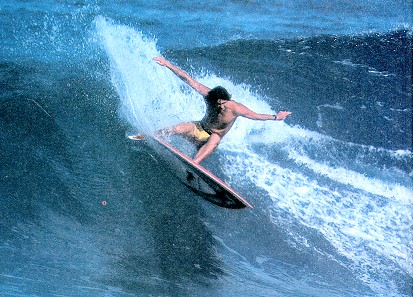 | **Mark Richards and 6ft 4'' Twin** **Off The Wall, 1977.** Photograph : Lance Trout **Surfing ** Magazine February 1980. Volume 16 Number 2, page 90. |
| **Mark Richards and 6ft 4'' Twin** **Off The Wall, 1977.** Photograph : Lance Trout **Surfing ** Magazine June-July 1978. Volume 14 Number 3, page 47 | 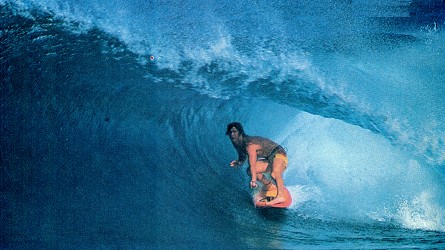 |
The design was tested in Hawaii the following winter and contest success in the Bells 1978 and Stubbies 1979 contests and the 1979 World tiltle proved its high performance capabilities, particularly in small waves. Available from all Australian manufacturers, it was the dominant small wave board design 1978 – 1981.
| Image right : Steve Brom and Rocket Fish, circa 1977. Photograph : Brian Gillogly Surfer Magazine, Volume 18 Number 2, page 57. July 1977. Note : Fins toed and tipped. Long base/short height profile. Estimated length 5 ft 10’'. Twin pin nose on vertical board. |  |
The design also had a strong following on the south shore of Ohau, notably Larry Bertlemann and ‘Buttons’, and
was to be extensively used in the USA.
Mark Richards models were made under licence by Gordon and Smith Surfboards.
House shapers were Hank Warner, Robin Prodanovich, Terry S. Goldsmith and E. Duck.
These were available with Star System fin boxes, a uncommon feature in Australian boards.
Advertisement : Surfing Magazine June 1981.Volume 17 Number 6, page 93.
 | **Mark Richards Twin fin, (est. 6 ft 3'')** **Gordon and Smith Surfboards** (USA) **Surfing** Magazine June 1981.Volume 17 Number 6, page 93. |
| **Star Systems Twin fin,** **Mark Richards Model** **Gordon and Smith Surfboards** (USA) **Surfing** Magazine May 1979. Volume 15 Number 5, page 9. |  |
In Australia, the design was shaped by Mark Platter, Ken Freeland and Tony Cerff at Maddog Surfboards.
Mark Richards Surfboards (single fin designs) were first manufactured by Morning Star Surfboards, Mona Vale.
The fin to flyer channels rarely appear on later/copied examples.
The ribbon decals were early designs, gradually replaced by a MR/Lightning Bolt, a MR script and a MR/Lizard graphic.
Apparently the famous MR/Superman logo only appeared on Mark Richards’ personal boards during this early period.
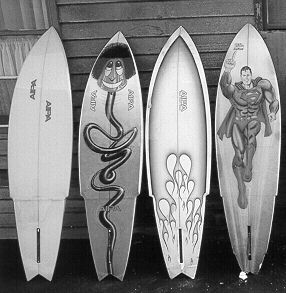
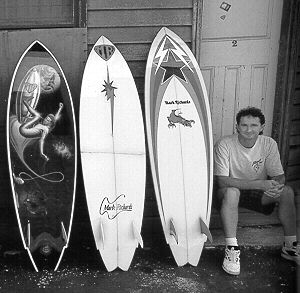 Photograph by Peter Boskovic
Printed in **The Australian Surfers Journal** Vol 1 # 3 Winter 1998 page 44
Note : Original Apia Surfboards 'Flame' Stinger, Twin fins with various decals.
All boards much photographed.
Photograph by Peter Boskovic
Printed in **The Australian Surfers Journal** Vol 1 # 3 Winter 1998 page 44
Note : Original Apia Surfboards 'Flame' Stinger, Twin fins with various decals.
All boards much photographed.
**Other Twin Fins II (old Scale)**
This stuff is funny, Simmons did back i the wood days, and quite a few in between that and the growth of the popular version in the late seventies because of the Magazines hyping of MR. Hero worship and the magazines factor into the equation. Just like the thruster people did it before Simon, and just like the SUP and Laird. Anyways, I know I didn’t invent it but I appreciate all the designs, and all the people who contributed to it. For me the glory days of the twin were just before the thruster destroyed it around '80 -'81 at low tide 54th, with the Stussy guy’s like Mike Sharp doing their thing. John Gothard had it down too, Jeff Parker could really ride a Lance Collins Wave Tools, and so could Kwock. Some days Steve Richardson would walk down from his parent’s place on Sonora by river jetties. The energy moved south and focused on Newport, and Moir, and Dj were there to record it. The twin really fitted that wave well, and those were some good times.
In Florida while the big shops got in the M.R. clones…many of the best Florida surfers were riding Pin tail and double wing pintail twins. Even a few sqash tail twins. Some with channel bottoms. One of the best was John Holeman. Still kills it. I think what is lost on some folk that surf is each surfing community had it’s own bit of history and things likely shaped up differently and in some cases even prior to things written about in the magazines. We had a guy named Kirklighter who rode boards with 16’’ tails and 11’’ noses almost a decade before thrusters. Some of those channel bottom twin fins worked as well or better than the winger swallow ridden by M.R. but most of the Florida guys were not on the tour then. Greg, Tableling and Kech and a young Slater all rode the round tail variety at one time. I think Kech had something to do with the squash becoming popular riding a closed tail twin.
We left out Greg Loehr. I'm pretty sure he was pumping out those twins in the "70's -'80's as well.
now check my fin template against the other fins on those mr's, reno,etc.
you'll see that mine are competely different in template(smaller too 5-1/2"tall x 5-1/4" base)...........mine look more like thruster fins...........in 1980 no less.........and actually before this .
i was never much of a keel fin fan..........i rode them because that's what was avalible to me.
i got tired of others telling me,,,," i couldn't do it"..........or better yet............."they won't work".
so i built my own.........
my way................
with my own ideas!!
a comprise of my experiences.
_____________________________________________________________________
now it's up to you guys................
build it like everyone else...............
or build it your way...........
it your choice.
herb
Frank Sinatra said it in a song, ''........I did it, myyy waaaaayyy!''
(me too)
Funny about Holeman, I saw him in the early '80’s, when he came to 54, or as I called it “wannabe beach”, and was not impressed at all, he didn’t even fall into the third tier in my estimations. I thought maybe he was having troubles, and that is nothing against him, I just didn’t see it. The kind of talent someone like Steve Richardson had on a twinnie was mind-blowing, Ken Bradshaw told me the only one he had seen with that kind of talent was a kid then and his name is Kelly.



